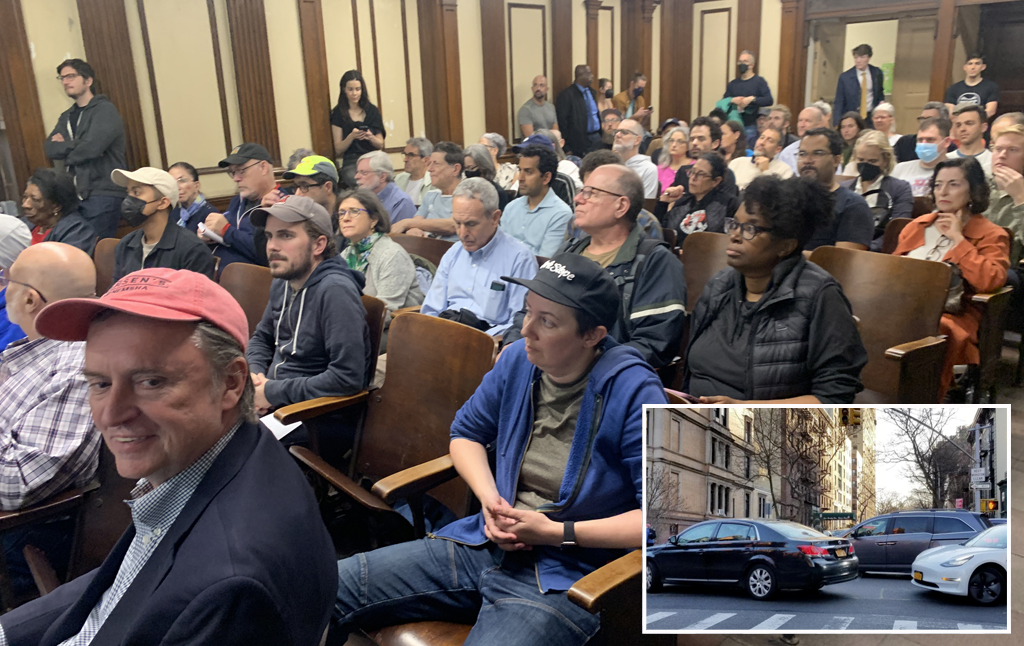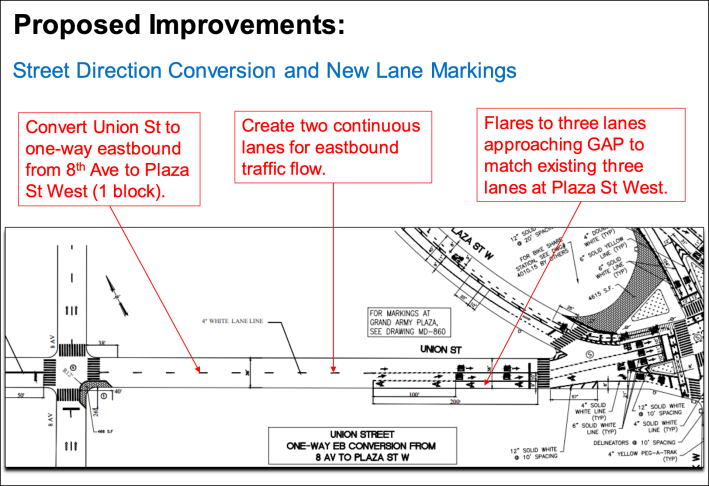Cycle of Rage: Hey, DOT, Fix the Bottle, Not the Bottleneck
Faced with a massive car clot in the heart of a tony residential neighborhood, the DOT has a plan to ... create more space for cars.
12:00 AM EDT on October 30, 2023

A large crowd for a committee meeting, but when it comes to cars, everyone is interested.
Here's a perfect reason why there should be a war on cars!
Faced with a massive car clot in the heart of a tony residential neighborhood in Brooklyn, Department of Transportation planners showed up at a community meeting on Thursday night with a plan to do ... what transportation planners typically do: create more space for cars.
But residents of Park Slope — most of them car owners, in fact — showed up by the dozens to ask a substantive question: Instead of trying to temporarily fix a single bottleneck, why not fix the bottle itself?
First, a little background: Everyone agrees that Eighth Avenue in Park Slope — a two-lane, synchronized-signaled mini-highway that drivers take from the Prospect Expressway to Flatbush Avenue to avoid all of the mess on the Brooklyn Queens Expressway — is failing.
How it is failing depends on one's perspective: As a cyclist and pedestrian, it fails me because the roadway is designed to quickly move cars (and nothing else) in large volumes from a highway to another arterial. There's no place for people who want to get around on bikes, including kids who go to the many schools along its route.
And it fails pedestrians, who are crammed onto narrow sidewalks, where they compete for space with garbage and dog-feces-filled tree pits. (Like I said, it's a tony neighborhood ... by New York standards.)
Residents say the roadway fails them because of the constant rush of cars and trucks along what they claim used to be a quiet residential street.
But drivers say Eighth Avenue fails them because of the aforementioned bottleneck: Northbound Eighth backs up epically at two-way Union Street because many drivers want to turn right to access the ultimate Brooklyn shitshow: the intersection of Flatbush Avenue, Eastern Parkway and Grand Army Plaza.
Here's a map of the whole area (zoom in for detail):
DOT came to Community Board 6's transportation committee on Thursday night to discuss the agency's plan to "fix" the problem by making Union Street one-way eastbound — to give more space to store eastbound cars as they wait at the light in Grand Army Plaza. In fairness, the agency deserves credit for seeking to address a problem of local concern. But the agency also deserves criticism for the way in which it sought to address a problem that needs a solution much bigger, much more thought out and much less, in the words of former Community Board 6 member Joanna Oltman Smith, "lazy."
Now, the proposal: The DOT is proposing to turn the 36-foot-wide Union Street into a one-way eastbound street, freeing up the current westbound lane for another lane for car drivers, providing two continuous moving lanes, that expands to three lanes at Grand Army Plaza (graphic below). The agency said this would save drivers four seconds per vehicle (no, seriously, four seconds), though even these speeds will likely be eliminated over time due to the notion of induced demand, which did not even come up at the meeting.

It didn't come up because an agency that knows better for some reason believes that "just one more lane" will solve the problem of congestion. Worse, the agency admitted that the 120 to 170 cars and trucks that currently use the rarely congested westbound lane of Union Street to get into the commercial core of Park Slope will be forced onto local residential streets, mostly President Street one block south.
Or, as one member of the transportation committee put it, "This whole proposal is like a waterbed. You push down on one side and it bulges up in another." (At least a waterbed gives the potential for rest; the proposal from DOT will only create space for more cars.)
JUST ONE MORE LANE BRO
— Alan Fisher (@alanthefisher) February 8, 2022
JUST ONE MORE LANE BRO
JUST ONE MORE LANE BRO
JUST ONE MORE LANE BRO
I SWEAR BRO JUST ONE MORE, I SWEAR https://t.co/1GaRw0b34K
At the community board committee meeting, agency rep Matt Lorenz said that there is capacity on President Street "to process" the additional volume, as if cars and their attendant road violence are merely the pork and spices that get turned into a delicious sausage. He also said the proposed extra lane on Union Street "opens up additional capacity that will relieve the spillback on Eighth Avenue."
He described Union Street as "over-capacity" because the level of service for drivers isn't good enough because the current two lanes carry 735 vehicles per hour in peak periods (sure, so drivers don't like the roadway, but neither does anyone else in the neighborhood).
"We're hoping to get Union Street under-capacity," he said. "Right now, people are inching up Eighth Avenue, they don't make the light, they inch up farther, they don't make the light. The goal is to get that continuous flow, so that when they get the green light they can get through the intersection. ... If you [add the new lane] that with that gives us more ability to store vehicles on Union Street rather than on Eighth Avenue."
This notion — "We need more space for all the cars because all the cars are taking up so much space" — is exactly how traffic engineers have long looked at problems like this. But it's actually counter to decades of innovative thinking about traffic, some of it coming from DOT itself.
The agency still does make a priority of increasing the "level of service" for car drivers, but it has shown, repeatedly, that when it reduces the level of service for car drivers, entire neighborhoods benefit. Just look at Paseo Park in Queens, Vanderbilt Avenue on any Saturday, the 39th Avenue bike boulevard in Queens, the 14th Street busway, Prospect Park West, the Willoughby Avenue open street, the holiday open street on Fifth Avenue, Jackson Avenue in the Bronx, and most of Broadway between 42nd Street and Union Square in Manhattan and you'll see the agency at its best.
We can't expect a driver to look in the mirror and say, "I have met the enemy ... and it is me," so that has to be the DOT's job. During a two-hour discussion about traffic and how to mitigate it, all the drivers blamed the "other" drivers who use Park Slope as a shortcut to get somewhere else. No one bothered to mention the pandemic car boom, which consisted of a rise in new cars in the neighborhood created by ... the people in the neighborhood.
"The traffic is so bad that I always have to drive around the block," said one woman. "This used to be a lovely residential historic district. But I don't know where all this traffic is coming from or where they're going."
Yes, yes we do. And DOT does, too, even if the presentation on Thursday didn't mention it. Fortunately, President Street resident Chris Weinstein did.
"It feels like you're addressing the problem of a bottleneck and maybe not considering the problem of the bottle itself," he said.
Weinstein recalled that when he moved to the neighborhood 20 years ago, Sixth Avenue was similar to Eighth Avenue is now. But it was changed to a two-way configuration and "everyone's been pleased with the fact that no one thinks of it as an expressway anymore," Weinstein said. "So has DOT considered the bottle: Changing Eighth Avenue so it is not an expressway?"
"We have not considered that," Lorenz said.
Responses like that prompted Oltman Smith to say, "This proposal is the laziest, the most simplistic, the least-holistic solution that could be presented by DOT for this long-standing crisis in our neighborhood."
Yeah, but the same thing can be said for her comment: It didn't mention that the true holistic solution starts with the acknowledging another hole — the one in car drivers' thinking.
The Community Board 6 Transportation Committee ended up tabling the matter, but it is likely to be discussed at a future date. To read the DOT presentation, click here. Gersh Kuntzman's Cycle of Rage columns are archived here.
Gersh Kuntzman is editor in chief of Streetsblog NYC and Streetsblog USA. He also writes the Cycle of Rage column, which is archived here.
Stay in touch
Sign up for our free newsletter
More from Streetsblog New York City
Friday’s Headlines: Canal Street Follies Edition
Manhattan Borough President Mark Levine isn't happy. Plus other news.
Daylight Again: Bronx Community Board Backs Parking Ban at Intersections
The Boogie Down is down with daylighting!
Community Board Wants Protected Bike Lane on Empire Blvd.
Brooklyn Community Board 9 wants city to upgrade Empire Boulevard's frequently blocked bike lane, which serves as a gateway to Prospect Park.
The Brake: Why We Can’t End Violence on Transit With More Police
Are more cops the answer to violence against transit workers, or is it only driving societal tensions that make attacks more frequent?
Report: Road Violence Hits Record in First Quarter of 2024
Sixty people died in the first three months of the year, 50 percent more than the first quarter of 2018, which was the safest opening three months of any Vision Zero year.




